"Nullius in Verba.
(Take nobody's word for it.)" -Motto of the Royal Society
You know the drill. New ideas come out all the time. Sometimes they're new theories, sometimes they're old theories with a new twist, but regardless, we need to ask the question: How good is your theory?
For whatever it's worth, I came up with a scale for this.

The best ideas are beyond validated. They are confirmed over and over, predict new phenomena that gets verified, and don't have any self-inconsistencies.
Well, a couple of weeks ago, a new twist on an old idea was proposed by Roger Penrose.
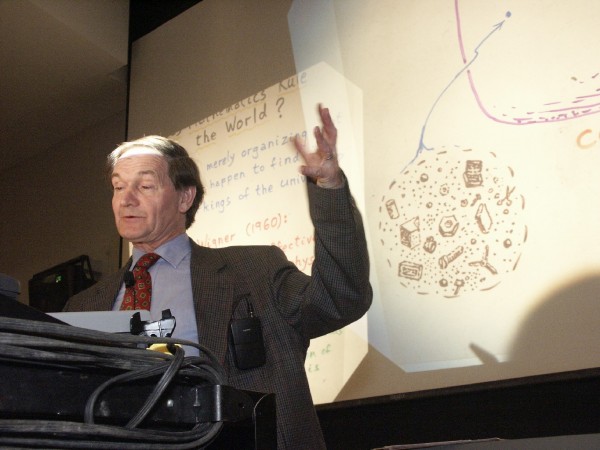
A little background first. Roger Penrose is a really bright guy, and -- among physicists and mathematicians -- is incredibly well-respected. His specialty is in the physics and mathematics of spacetime, including tilings and tessellations (below).
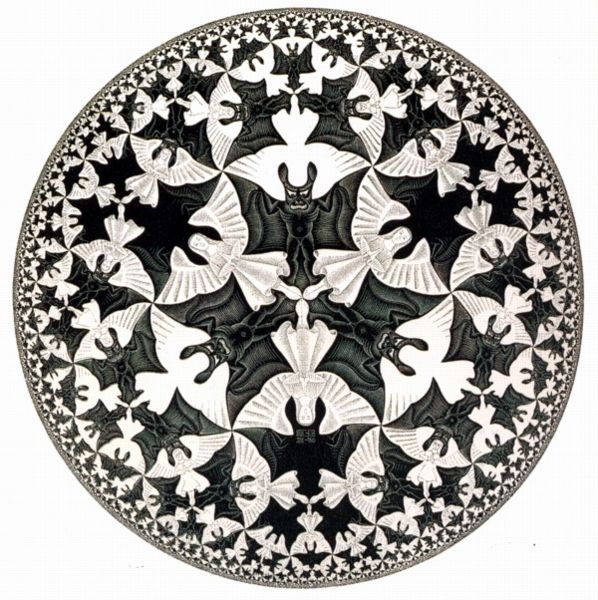
Penrose diagrams -- mathematical ways to map infinite spacetimes onto a simple sheet of paper -- are named after him. He also has a bit of fame from his work on singularities with Stephen Hawking.
Penrose has also been unafraid to put speculative ideas out there. He has been unafraid to speculate about the origins of consciousness, but at least some of his ideas were demonstrably wrong. One of his favorite speculative ideas is that of a cyclic Universe, which he's been touting (and speaking about) for as long as I can remember.
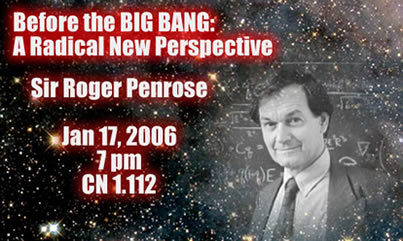
We have a theory of the Universe, and while it doesn't explicitly rule out cycles, the evidence strongly points towards a different story. As we've discussed a number of times, the first step in the Universe's history that we can sensibly say anything about is inflation.
Whatever the Universe was doing, at some point 13.7 billion years ago, some region of it was expanding exponentially fast, taking whatever shape it was and stretching it flat, across the Universe. At the same time, the tiny quantum fluctuations that happen all around us -- all the time, like it or not -- also got stretched across the Universe.
When inflation ended, and this energy turned into matter and radiation, the regions with positive fluctuations came out with slightly higher-than-average densities, and the regions with negative fluctuations came out with slightly lower-than-average densities.
A few hundred thousand years later, the overdense regions have grown a little bit thanks to gravity, the underdense regions have shrank a little bit more, and the leftover radiation from the big bang shows us this "fingerprint" in the form of fluctuations on the sky in the cosmic microwave background.
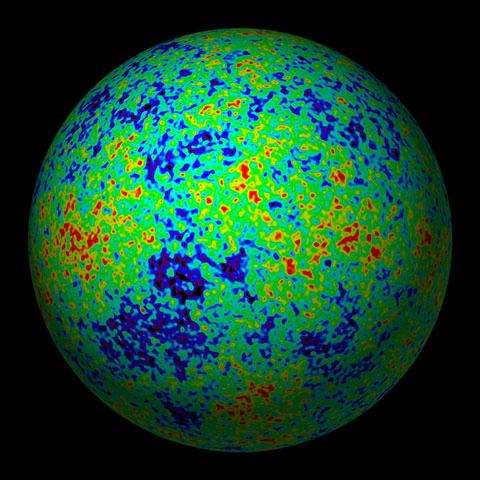
Now, we can use this "fingerprint" to learn about the Universe. If inflationary theory is correct, these fluctuations should follow a
Did Stephen Hawking write his initials in the microwave sky? It certainly looks like it!
But, as a cosmologist, there's no need to panic. Instead, we ask ourselves if patterns like this come about naturally from the fluctuations we expect, or whether these patterns are indicative of some physics beyond our current understanding of the Universe.
So we not only do our mathematical analyses, we also run simulations of millions and millions of Universes, the way we think it works. How frequently do we expect features like this to show up in our sky? The answer, surprisingly, is very often.
That's good! That means our picture of the Universe -- inflation + the big bang -- is perfectly consistent with what we see. Now, let's take a look at Penrose's new idea.

He found -- quite surprisingly -- that there are regions of space, shaped like concentric rings, where the temperatures are much more uniform than average. In other words, the amplitude of the fluctuations are anomalously low in these concentrically-shaped regions of space.
So, you might think to ask yourself, how common are features like this? Is this in conflict with what we think the Universe is supposed to look like, or is this completely reasonable and consistent with what we expect? But Roger Penrose didn't ask that question.
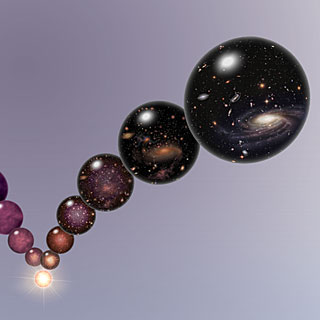
Instead, this finding was touted -- by Penrose -- as evidence that inflation is wrong, we live in a cyclic Universe, and these concentric circles are evidence of the Universe that existed before ours.
Fortunately, as soon as Penrose pushed this paper, cosmologists were all over it. (Thanks to Sarah and Sean for writing about this first.) What did we find?
These features are normal, and completely within the realm of what we expect. So Penrose's idea -- that inflation is wrong and we live in a cyclic Universe -- is my favorite kind of invalid theory.

The kind that's demonstrably wrong. Why is that my favorite? Because we learn from it.
That's one of the ways that science advances: we put out speculative ideas at the limits of our understanding, we test them for validity, and if we find the idea doesn't hold up to the data, we cast it aside. And we do it, at least, until there's new evidence that causes us to take it up again. So I hope you not only learned a little bit about a new idea, but that you also learned a lot about what we actually know, and how we know it!

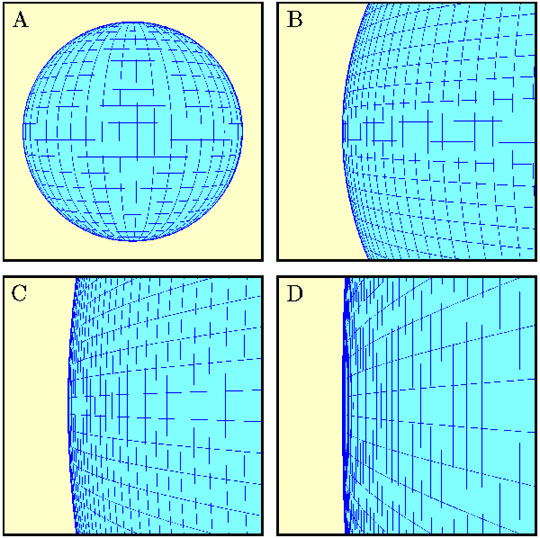
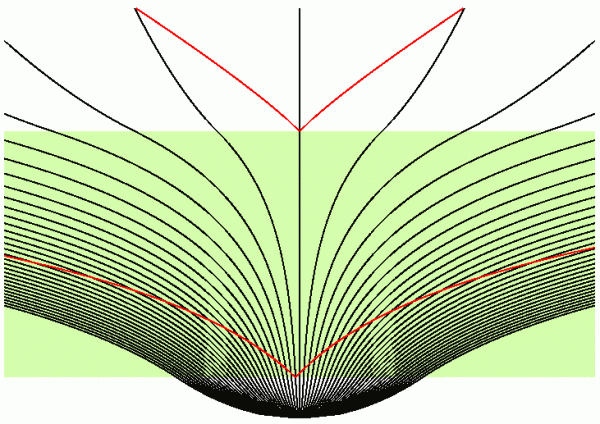
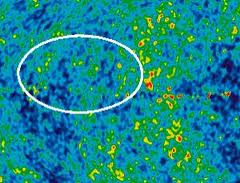

It should stressed that Penrose doesn't propose the conventional sort of cyclic model that inspired the penultimate image in this entry, but something much odder wherein a supercold old heat-dead universe with (crucial caveat) only massless particles can be "mapped" onto a superhot young rapidly expanding universe with only massless particles.
Penrose argues that this is justifiable because massless particles have no rest frame and so the concepts of time and distance do not necessarily apply to them in the same sense as they do to massive particles.
Selamun Aleyküm ve Rahmetullah KardeÅlerim Sizlerle 2. Yazımı Nasipse inÅeeAllah PaylaÅıyorum Bu Seferki konumuz Allah ve kalp baÅlayalım inÅeeAllah
Bismillahirrahmenirrahim
Sevgili kardeÅlerim Allah ve kalp dendiÄinde aklıma zikr hali gelmektedir. Allah a ulaÅmak için vukufi kalbi yani kalbe vakıf olmak gerekir . Ãünkü Rabbimiz kulunun kalbine bakar ve ona göre tecelli eder ona göre kuluna hüküm verir Bir hadisi Åerifte buyrulduÄu gibi ;
Ameller niyetlere göredir.
Woo hoo! That's from my article I posted here (which is of course the only place anyone could have possibly seen it).
In all seriousness, thanks for looking into this one, I have seen several more articles about this case - some for the idea and some against. To me it does seem a little far fetched to see a 'sign' in microwave ...waves, but you never know.
I had another question I wanted to ask, but now I have forgotten it, so you may see me post again somewhere on here. But thanks for all you do; Starts With A Bang has become one of my favorite science blogs to visit (with only Bad Astronomy coming anywhere close).
Ethan, nice job as usual, and I was right with you up to the last three paragraphs.
From the three papers you cite:
"We have conï¬rmed the presence of the low-variance circles in the CMB sky found by GP10. However, we have shown that such circles are to be expected in typical realizations of the CMB sky..."
"By comparing with Monte Carlo simulations of the CMB sky, we ï¬nd that the low variance circles of Gurzadyan & Penrose (2010) are not anomalous. They can naturally occur in a Gaussian CMB sky consistent with the predictions of the inï¬ationary cosmology."
"Thus, we conclude that there is no evidence for the CCC model in the current WMAP data. Of course, Planck (Tauber et al. 2010) may provide new light on this issue, having higher sensitivity and resolution than WMAP, but one should probably not have too high expectations in this regard. Even if the CCC model should turn out to describe the real universe, it will quite likely be diï¬cult to unambiguously identify such concentric circles due to the dominant background cosmic variance."
You then go on to say: "So Penrose's idea -- that inflation is wrong and we live in a cyclic Universe -- is my favorite kind of invalid theory. ... Ruled Out"
It seems to me that what the three papers have shown is that the specific features that Gurzadyan & Penrose pointed to as evidence are not significant evidence at all. They say nothing about the validity of the theory; just that this evidence for it doesn't stand up.
If I find a black sheep, and you wash it, find that it is covered in coal dust, and show me that it is not black, you have not "ruled out" the existence of black sheep everywhere.
Would it not, then, be more correct to assign the theory somewhere (slightly) to the left of "ruled out"?
jim, what was "ruled out" was the hypothesis that these circles were evidence of pre-inflation influences. If these are not evidence, then what data is there to support pre-inflation influences?
A hypothesis has to make predictions. If it makes predictions that are observed to be in conflict with the data, then it is "ruled out". The Penrose hypothesis was that pre-inflation structures would produce statistically significant concentric circles in the CMB. The circles that are observed are not statistically significant, so his hypothesis is falsified.
There might be another hypothesis that pre-inflation events would produce something else that is observable, but that is not the hypothesis that was being proposed or tested, that would be a different hypothesis.
Ethan is quite right, it is important to keep very strict track of what we are meaning when we propose a hypothesis and what its limits are, so that we can make progress if it turns out to match the data, or even if it does not.
Roger Penrose Has been an inspiration to me for a very long time, I view his tilings as a first step in the development to Mandelbrot's fractal geometry. (great stuff)
I too lean heavily towards a theory of cyclic Universe though one that does incorporate an era of great expansion(inflation).
Maybe he is not right as they say about the sphere phenomena generating a circle pattern in the CMB Cosmic Microwave Background, However, he has been around the block as one would say, and I do believe he is a very intelligent physicist...I probably would discount his theory as a whole complete concept, yet a concept investigating the micro-arrangement of past produced patterns may yet still hold some significance and should not be totally relegated to the scape pile.
Agreed, This seems an unlikely determination, yet in conjunction with as yet other undiscovered phenomena may hold some significance, and yes I am being kind to a man who has shown me much, and yes I am old enough to realise that a partial truth may be at hand and that it may not be realised for many years.
I have watched his latest videos and could speculate to where this is leading, Roger Penrose (in my book) is a gifted theorist as we all know, and what he is not saying may yet hold some validity and in time come to fruition.(if you know what I mean).
I love it that he still has something to say and you can tell from his enthusiasm that he loves physics and for that I am willing to read between the lines to sync. his thought pattern for a glimpse of a possible additional view.
Did I say? I think he is a great man, and an extraordinary thinker.
Thanks to jim and daedalus for their clarifying comments. It appears Ethan was a bit ambiguous concerning the hypothesis and the theory in his writeup. According to what daedalus said so well, what was disproved was the hypothesis that these rings are evidence of a cyclic universe, not the "theory" of a cyclic universe itself. This does provide (further) evidence that the universe is not cyclic, but certainly not all that much more so than before this experiment was performed (it being a disfavored scientific theory to begin with.)
I must agree with the commenters above.
These findings in no way rule out CCC, they just make this evidence to be very likely wrong (though not even with metaphysical certitude, which is what I would assign to the very right end of Ethan's scale!)
I don't like that linear yes-to-no scale. Real life is more complex. My favourite way to describe the evolution of an idea is a triangle, whose corners are "true", "not true", and "not known". The idea starts at "not known". As facts become available it moves towards "true" or "not true" along a path the resembles a Brownian random walk. Most ideas are on the move, because they lack definitive proofs. Indeed, the corners are reserved only for mathematics. In physics you'll never reach a corner, only get close enough for practical purposes.
The triangle may be applied in several contexts. For example, CCC can be treated as a theoretical model or as an attempt to model the actual universe we live in. In theoretical sense it has advanced to some degree, but as an actual model it is still pretty close to the starting point.
BTW, from your text one might think that Penrose drew the angels/devils tiling, but of course we all know you just forgot the credits.
http://en.wikipedia.org/wiki/M._C._Escher
As usual, great post. However, it is somewhat dangerous to imply that well supported theories eventually can be considered scientific laws. This feeds the goofiness that the science denying creationists use to rail against evolution. In science, it must be stressed, a Law and a Theory are two distinct things, and the latter never becomes the former, no matter how much supporting evidence is procured.
arama motorlari en iyi yerlere gelmek istiyoruz However, it is somewhat dangerous to imply that well supported theories eventually can be considered scientific laws. This feeds the goofiness that the science denying creationists use to rail against evolution. In science, it must be stressed, a Law and a Theory are two distinct things, and the latter never becomes the former, no matter how much supporting evidence is procured. thank you
Let me summarize
1)Penrose predicts CMB concentric circles
2)Concentric circles are found in the CMB observational data
3)Standard model cosmologists tweak their CMB simulation model and NOW find concentric circles; then proclaim that "properly simulated Gaussian CMB data contain just the sorts of variations claimed."
Forgive my skepticism of the new "properly simulated" CMB simulation by the standard model cosmologists. Are they suggesting that previous CMB simulations were improper (i.e. wrong); because they didn't previously show concentric circles?
And by the way the concentric circles are quite different than Stephen Hawkings initials. That's a low blow; as is the comment "But Roger Penrose didn't ask that question."
Even if Penrose's current prediction is not what he suggests; do you prefer the current HALF-cyclical Big Bang MODEL of our visible universe.
The rain comes down, flows into streams, rivers and finally the ocean. (a half-cycle model of rain) But after a few millennium, our ancestors understood that the sun lifts the ocean back up to the sky to form clouds which rain. (a full-cycle model of rain).
If you are going to BELIEVE in the big bang model; at least believe in a full-cycle rather than a HALF-cycle version.
The old steady state model "require(d) that new matter must be continuously created... roughly one hydrogen atom per cubic meter per billion years". I'm not advocating this model; but there is a lot of wiggle rum for a full-cycle model of our universe.
"Roger Penrose is a really bright guy, and -- among physicists and mathematicians -- is incredibly well-respected. His specialty is in the physics and mathematics of spacetime"
Is Penrose also incredibly well-respected among astronomers??
If astronomers can't convince Roger Penrose that the Big Bang half-clyclical-Model of our universe is correct; then why should we not also be skeptical.
You've convincingly explained that there is a super gigantic matter/energy drain at the center of each galaxy (i.e black holes); doesn't that scream for a mechanism (probably a quantum mechanism) for that matter to be somehow lifted back up into our visible universe. (And mechanisms that require 10^67 times the age of the universe, i.e. Hawking's radiation, for the return cycle do not count as a credible explanation.)
@OKThen: Your point 3 is wrong - standard model cosmologists did not "tweak" their model. They simply used the already well-established model and looked for the first time what predictions it made concerning this particular feature. And they aren't suggesting that previous simulations were not "proper" - they simply did not look for this particular feature in previous simulations.
And I don't understand at all why it should follow that the Big Bang has to follow a "full cycle" from the fact the rain follows a full cycle - looks like a totally invalid analogy to me...
Err, no - why should it?
@10, DataJack,
While you are right that not all theories become laws, all laws start out as theories.
For example, I could put forward a theory that gravity is universal and constant in not only our universe, but every potential universe. That no matter how you create a universe gravity will always have the same values. I would call it the Law of Constant Multi-Universal Gravity, or something. Whatever.
This could be true or not, and we could prove it true or not eventually, but it doesn't HAVE to be true, so it starts out as a theory, but we could upgrade it to a law if we found it always held true, every time.
Newtons three Laws started out as hypothesis too.
Don't get hung up on semantics. Scientific law = scientific fact and simply means confirmed to such a degree that it would be perverse to withhold provisional assent. (as has been stated before).
The scale that Ethan is using is is using real numbers (which are non-physical because reality doesn't seem to be infinitely divisible), so there is still infinite space between any two points on the scale. That scale is just a short cut for the actual arguments and data that it represents.
What matters is not what we call the stuff of science but how we treat it. If everything remains up for revision, then whether we call it a law, a fact, a hypothesis doesn't really matter. But when a hypothesis is supported by extraordinary amounts of data (as is evolution, germ theory, CMB, relativity, quantum mechanics, etc), it takes extraordinary data to call it into question.
OKthen, it is not what any physicist prefers, it is what does the data allow and what does it rule out. Stopping when you have a hypothesis that you like isn't good enough. Our aesthetic sense evolved to help our ancestors live in the trees and on the savanna. It did not evolve to help us figure out quantum physics and relativity and a GUT that combines them.
Atatürk Olimpiyat Stadıânda saat 17.00â²de baÅlayacak karÅılaÅmada batı numaraları tribün ev sahibi ekip taraftarlarına, doÄu kapalı tribün ise konuk Trabzonsporlu taraftarlara ayrıldı.
"So, you might think to ask yourself, how common are features like this?...But Roger Penrose didn't ask that question. "
This is simply not true. See Figure 2c of the Penrose paper. They did consider it. The other groups find different simulated plots, and to be honest, the other groups are more likely to be right. And there are some non-obvious "data-mining" type statistical effects that it seems very possible were overlooked. My take is that G&P considered it, but did so incorrectly.
Also, I am not sure the other papers addressed the concentric circle finding. They showed that seeing circles is not unusual, but in skimming I didn't see anything about concentric circles, as emphasized in the Penrose paper. Perhaps I missed that.
There's been multiple comments about whether the rebuttal papers put this in the "Ruled Out" category. The rebuttal papers demonstrate that there is no significant signal here. If all CCC models predict the existence of the particular signal (both in character in magnitude) that the Penrose paper claims, then yes, it's Ruled Out. If the model is tweakable, the papers put it into the "No reason to believe it" category.
Finally, I have to say, if I had a nickel for every meaningless statistical fluctuation that a theorist had gotten excited about, I'd get to eat a lot more at Chez Henri restaurant.
Laws do not start as theories. Laws are observations, theories are explanations.
It's like this:
Fact: An objective and verifiable observation
Law: a scientific generalization based on empirical observations of physical behavior
Theory: a functional and parsimonious explanation of a group of facts (and possibly laws)
Hypotheses become theories, if they are well supported. Either can be falsified.
Laws do not explain, they describe. Newton put forth what masses do in the presence of gravity. Einstein also explained why (curving of space/time).
GR will never be a law, it is so much bigger than a law already.
Gould's quote concerning if it "would be perverse to withhold provisional assent" referred to facts (observations) and he was quite clear about that.
Sorry, pet peeve. I'll behave now.
@DataJack: Very nice and concise explanation! (I wholeheartedly agree, BTW)
Also, watch out for the human tendency to find signals and patterns whether they are there or not. In case anyone hasn't seen it, fMRI on a dead salmon produced results that would have excited many researchers if they had been produced by scanning a living subject.
I disagree. Just because his evidence fits our current model doesn't mean his theory is RULED OUT... It just makes it speculative. In order to rule out a theory it must be PROVEN WRONG.
Datajack, Can you point me to a reference that carefully defines the distinction between fact, law and theory, hypothesis, Principle and Model.
Wikipedia is not the nuanced source for scientific philisophic definitions.
Or can you answer some clarifying questions:
- Is the mass of an electron a fact or a result of calculations based on some theory? Is the bare mass of an electron a fact, a hypothesis or a theory? And finally is the gravitational mass of an electron (which presummably has never been observed) a hypothesis versus the inertial mass (a fact).
- Is "action at a distance" a hypothesis of Newton's Law of Gravity; and thus is not Newton's Law of Gravity a theory?
- Is the Uncertainty Principle a theory or a law and uncertainly it is a hypothesis that is continually tested in new ways (e.g. recent entanglement experiments).
- Why is the Theory of General Relativity "much bigger than a law"? How about Einstein's Principle of Equivalence, is that a law or is it a hypothesis that needs to be tested again e.g. once we can put together a large amount of antimatter.
- Is the "Big Bang Theory" the better name the "Standard Model"?
Sincerely, I'm not convinced; but am interested if anyone has carefully defined such destinctions.
Wendy is right of course.
Penrose's "favorite speculative idea.. of a cyclic Universe" hasn't been ruled out; it just continues to be speculative. And a very reasonable speculation indeed!
So, let's see if I understand this. You have proclaimed that Penrose is wrong. No "maybe", no "could be". Just he is 100% wrong and you are 100% right in declaring his theory to be the disproven. And you have brilliantly shown all the proof of this in this one page article. Am I correct in my understanding?
Ä°stanbul Terörle Mücadele ve Ä°stihbarat Åube müdürlükleri ekiplerinin, bölgede
ÅiÅliâde Ä°stanbul polisinin helikopter destekli terör operasyonu yaptı. Alınan bilgiye göre hücre üyesi oldukları ileri sürülen bazı kiÅiler gözaltına alındı.
Abide-i Hürriyet Caddesi üzerinde bulunan Atlas apartmanına düzenlenen helikopter destekli operasyonda DHKP-C terör örgütünün hücre evine yapılan baskında, örgüt üyesi oldukları iddia edilen bazı Åahısların gözaltına alındıkları öÄrenildi.
I read this blog pretty often, based just on the titles that I find at ScienceBlogs, and I am consistently pleased with the writing quality that I find here.
Durgadas Datta published balloon inside balloon theory of matter and antimatter universe on opposite entropy path producing five GOD PARTICLES and injected into our universe as DARK ENERGY OR SPACE by annihilation at common boundary and when one reach tends to zero entropy BIG BOUNCE OCCCUR ETC ETC RE CYCLIC FOR EVER ...... PLEASE READ FURTHER FROM MY FACE BOOK LINK......
Right now I don't understand how CCC theory can explain expansion of the (observable) universe since as I understand CCC theory assumes a pre-existing space-time.
On the other hand how can you explain the flat geometry of the observable universe if it is expanding? Strange.
"On the other hand how can you explain the flat geometry of the observable universe if it is expanding? Strange."
No, topology
:-)
The conclusion does not follow the argument.
All we know is both theories follow logical but speculative assumptions and both match the current evidence such as it is.
The only objective statement that can be made regarding the two competing theories, is that the theory of inflation is more entrenched and more popular, but truth is not a popularity contest.
"but truth is not a popularity contest."
But losing a popularity contest doesn't mean it's true. So what, given that truism, is the point of your claim here?
Consensus is not a popularity contest. We don't send out polls asking scientists "Which option do you prefer?".
So you don't appear to know anything about scientists, never mind about science.
So what reasoning would you give for anyone to consider your statements and contemplate them further? Why should the failure of Penrose to create a theory that explains things better than "It just looks that way because we looked for it"?